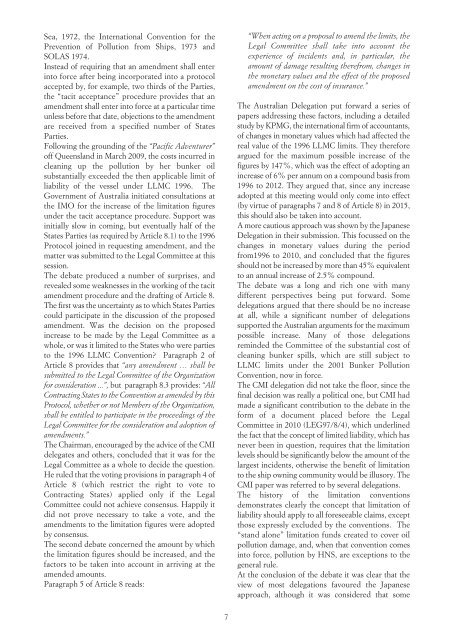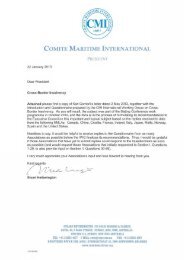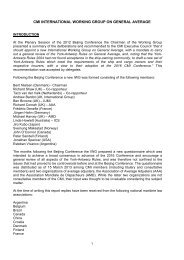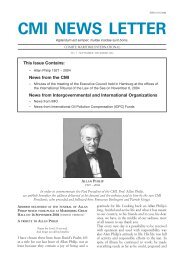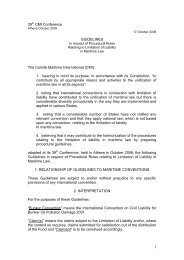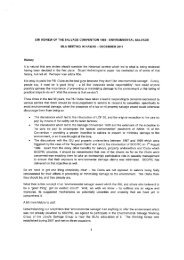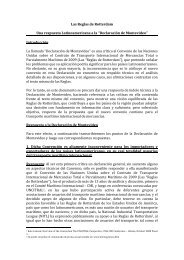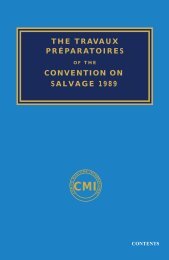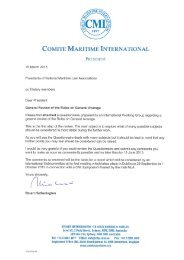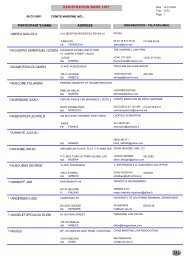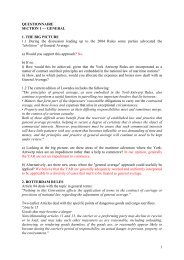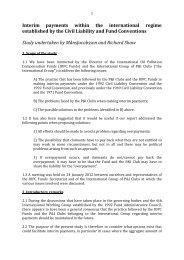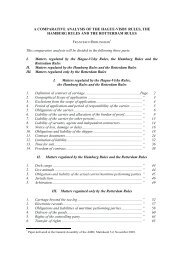CMI Newsletter n° 1 - Comite Maritime International
CMI Newsletter n° 1 - Comite Maritime International
CMI Newsletter n° 1 - Comite Maritime International
Create successful ePaper yourself
Turn your PDF publications into a flip-book with our unique Google optimized e-Paper software.
<strong>CMI</strong> News 2012-1_1 2012 18/06/12 16.22 Pagina 7Sea, 1972, the <strong>International</strong> Convention for thePrevention of Pollution from Ships, 1973 andSOLAS 1974.Instead of requiring that an amendment shall enterinto force after being incorporated into a protocolaccepted by, for example, two thirds of the Parties,the “tacit acceptance” procedure provides that anamendment shall enter into force at a particular timeunless before that date, objections to the amendmentare received from a specified number of StatesParties.Following the grounding of the “Pacific Adventurer”off Queensland in March 2009, the costs incurred incleaning up the pollution by her bunker oilsubstantially exceeded the then applicable limit ofliability of the vessel under LLMC 1996. TheGovernment of Australia initiated consultations atthe IMO for the increase of the limitation figuresunder the tacit acceptance procedure. Support wasinitially slow in coming, but eventually half of theStates Parties (as required by Article 8.1) to the 1996Protocol joined in requesting amendment, and thematter was submitted to the Legal Committee at thissession.The debate produced a number of surprises, andrevealed some weaknesses in the working of the tacitamendment procedure and the drafting of Article 8.The first was the uncertainty as to which States Partiescould participate in the discussion of the proposedamendment. Was the decision on the proposedincrease to be made by the Legal Committee as awhole, or was it limited to the States who were partiesto the 1996 LLMC Convention? Paragraph 2 ofArticle 8 provides that “any amendment … shall besubmitted to the Legal Committee of the Organizationfor consideration ...”, but paragraph 8.3 provides: “AllContracting States to the Convention as amended by thisProtocol, whether or not Members of the Organization,shall be entitled to participate in the proceedings of theLegal Committee for the consideration and adoption ofamendments.”The Chairman, encouraged by the advice of the <strong>CMI</strong>delegates and others, concluded that it was for theLegal Committee as a whole to decide the question.He ruled that the voting provisions in paragraph 4 ofArticle 8 (which restrict the right to vote toContracting States) applied only if the LegalCommittee could not achieve consensus. Happily itdid not prove necessary to take a vote, and theamendments to the limitation figures were adoptedby consensus.The second debate concerned the amount by whichthe limitation figures should be increased, and thefactors to be taken into account in arriving at theamended amounts.Paragraph 5 of Article 8 reads:“When acting on a proposal to amend the limits, theLegal Committee shall take into account theexperience of incidents and, in particular, theamount of damage resulting therefrom, changes inthe monetary values and the effect of the proposedamendment on the cost of insurance.”The Australian Delegation put forward a series ofpapers addressing these factors, including a detailedstudy by KPMG, the international firm of accountants,of changes in monetary values which had affected thereal value of the 1996 LLMC limits. They thereforeargued for the maximum possible increase of thefigures by 147%, which was the effect of adopting anincrease of 6% per annum on a compound basis from1996 to 2012. They argued that, since any increaseadopted at this meeting would only come into effect(by virtue of paragraphs 7 and 8 of Article 8) in 2015,this should also be taken into account.A more cautious approach was shown by the JapaneseDelegation in their submission. This focussed on thechanges in monetary values during the periodfrom1996 to 2010, and concluded that the figuresshould not be increased by more than 45% equivalentto an annual increase of 2.5% compound.The debate was a long and rich one with manydifferent perspectives being put forward. Somedelegations argued that there should be no increaseat all, while a significant number of delegationssupported the Australian arguments for the maximumpossible increase. Many of those delegationsreminded the Committee of the substantial cost ofcleaning bunker spills, which are still subject toLLMC limits under the 2001 Bunker PollutionConvention, now in force.The <strong>CMI</strong> delegation did not take the floor, since thefinal decision was really a political one, but <strong>CMI</strong> hadmade a significant contribution to the debate in theform of a document placed before the LegalCommittee in 2010 (LEG97/8/4), which underlinedthe fact that the concept of limited liability, which hasnever been in question, requires that the limitationlevels should be significantly below the amount of thelargest incidents, otherwise the benefit of limitationto the ship owning community would be illusory. The<strong>CMI</strong> paper was referred to by several delegations.The history of the limitation conventionsdemonstrates clearly the concept that limitation ofliability should apply to all foreseeable claims, exceptthose expressly excluded by the conventions. The“stand alone” limitation funds created to cover oilpollution damage, and, when that convention comesinto force, pollution by HNS, are exceptions to thegeneral rule.At the conclusion of the debate it was clear that theview of most delegations favoured the Japaneseapproach, although it was considered that some7


